Polyarylsulfone Market Size
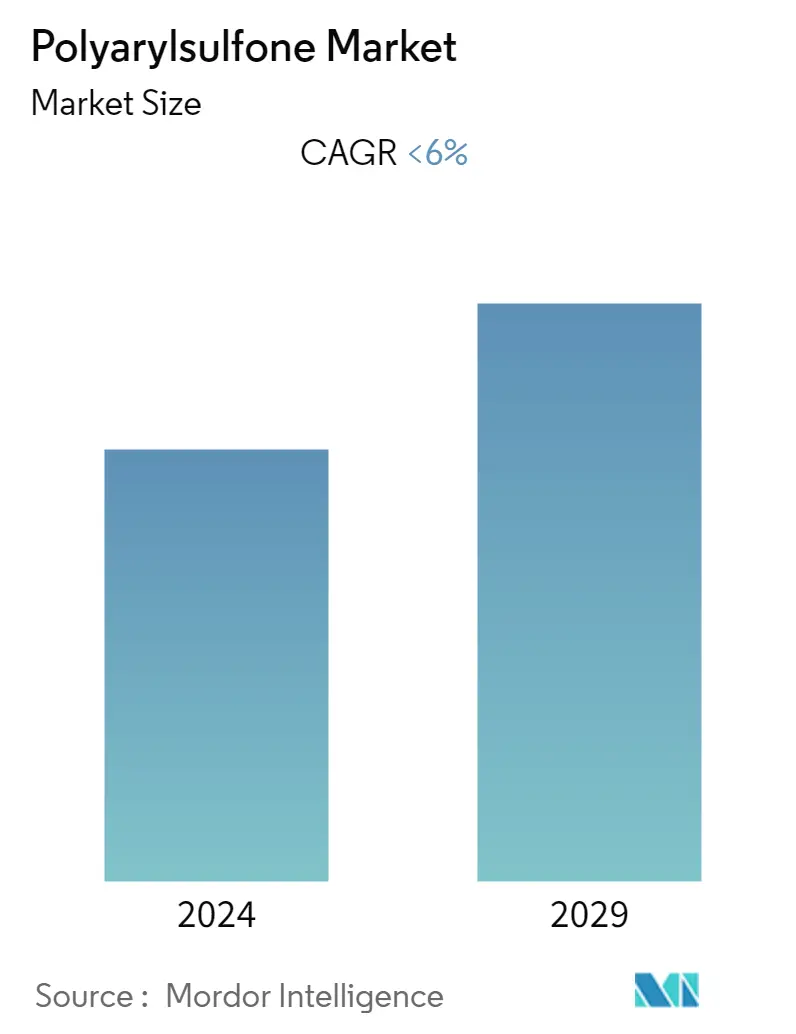
| Study Period | 2019 - 2029 |
| Base Year For Estimation | 2023 |
| CAGR | 6.00 % |
| Fastest Growing Market | Asia Pacific |
| Largest Market | Asia Pacific |
| Market Concentration | High |
Major Players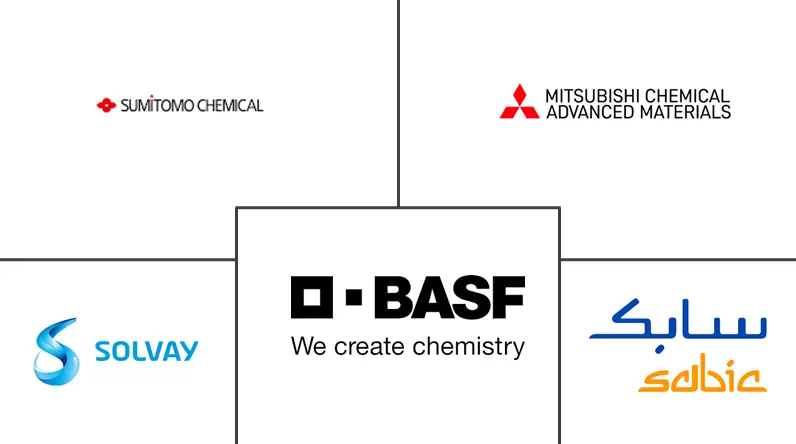
*Disclaimer: Major Players sorted in no particular order |
Polyarylsulfone Market Analysis
The polyarylsulfone market is estimated at USD 2,251 million currently and is expected to reach USD 3,027 million over the forecast period, registering a CAGR of around 6% during the forecast period.
Due to the COVID-19 outbreak, nationwide lockdowns worldwide, disruption in manufacturing activities and supply chains, and production halts negatively impacted the market in 2020. However, the conditions started recovering in 2021, restoring the market's growth trajectory.
- The major factor driving the market studied is the growing demand for polyarylsulfone from the automotive industry.
- On the flip side, stringent regulations on the hazardous nature of raw materials and unfavorable conditions due to the COVID-19 outbreak are hindering market growth.
- The growing demand for polyarylsulfone as a membrane in water treatment facilities is forecasted to offer various opportunities for market growth over the forecast period.
- Asia-Pacific region represents the largest market and is expected to be the fastest-growing market over the forecast period owing to the increasing consumption from countries such as China, India, Japan, and South Korea.
Polyarylsulfone Market Trends
Growing Demand of Polyarylsulfone from Automotive Industry
- Polyarylsulfone includes a wide range of applications in the automotive industry. Polyethersulfone (PESU), for example, is used in the cooling water and oil circuits in vehicle electrics (housing and connectors) and transmissions. Polyarylsulfone can be used in the temperature range from -100 to +200 °C.
- Owing to a huge growth in population, rising per capita income, and economic development in countries like China, India, and other ASEAN countries, these factors will drive the automotive industry significantly in the Asia-Pacific region.
- According to the Organisation Internationale des Constructeurs d'Automobiles(OICA), in 2022, around 85.01 million vehicles were produced across the globe, witnessing a growth rate of 5.99% compared to 80.205 million vehicles in 2021. It indicates an increased demand for gaskets from the automotive industry. In 2022, around 60 million passenger cars were manufactured worldwide, up nearly 7.35% compared to 2021.
- Developing countries such as China, India, Japan, and South Korea are working hard to strengthen the manufacturing base and develop efficient supply chains for greater profitability. According to the China Association of Automobile Manufacturers (CAAM), China includes the largest automotive production base in the world, with a total vehicle production of 27 million units in 2022, registering an increase of 3.4 % compared to 26 million units produced last year.
- In North America, according to the OICA, automotive production in 2022 accounted for 14,798,146 units, an increase of 9.88% compared to the production in 2021, which was reported to be 13,467,065 units. Additionally, in North America, the sales of electric vehicles in 2022 accounted for 1108 thousand units, compared to 748 thousand unit sales in 2021.
- In Europe, Germany is among the key manufacturer of vehicles. The automobile manufacturing industry in Germany is a prominent shareholder of the overall automotive production in the European region. The country hosts major car-making brands, including Volkswagen, Mercedes-Benz, Audi, BMW, Porsche, etc. Further, According to the Organisation Internationale des Constructeurs d'Automobiles(OICA), in 2022, the country produced 3,677,820 vehicles which increased by 11% compared to 3,308,692 vehicles in the same period in 2021. It thereby indicates an increased demand for industrial gases from the automotive industry.
- Hence, owing to the abovementioned factors, the application of polyarylsulfone from the automotive industry will likely dominate during the forecast period.
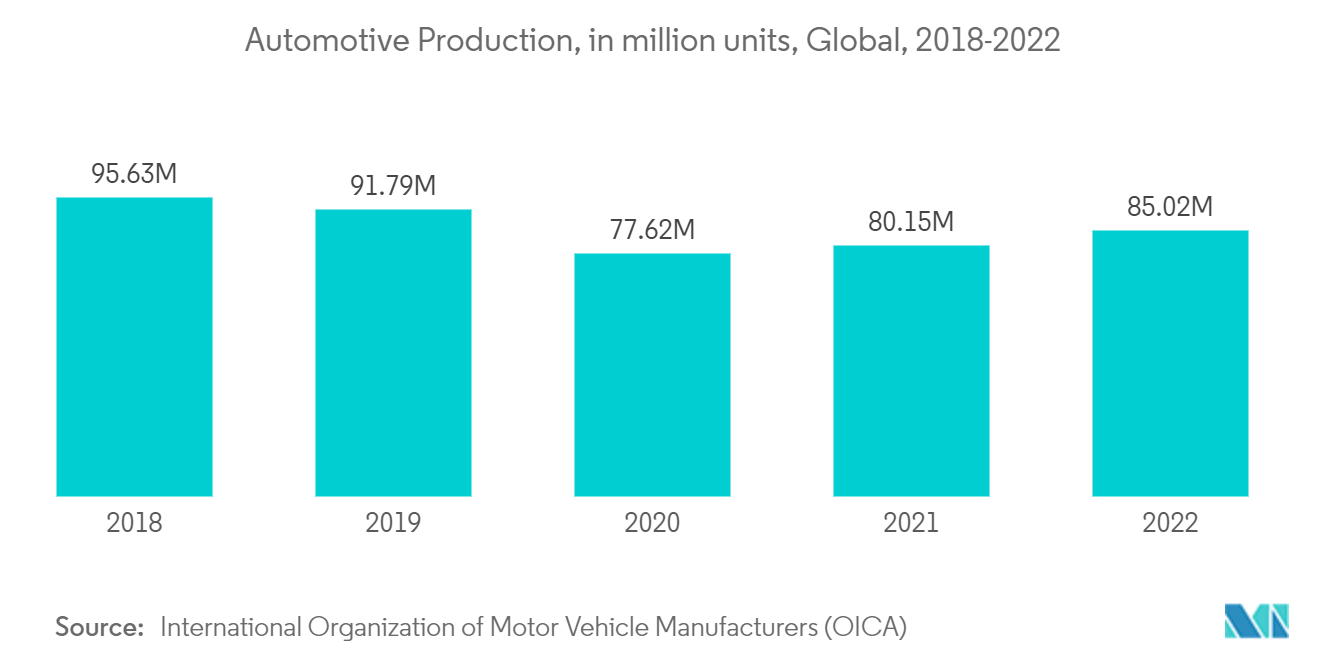
Asia-Pacific Region to Dominate the Market
- The Asia-Pacific region is expected to dominate the market for polyarylsulfone during the forecast period. The rising demand for polyarylsulfone from the automotive and aviation industry in developing countries like China, Japan, and India is expected to drive the demand for polyarylsulfone in this region.
- The largest producer of polyarylsulfone includes a presence in the Asia-Pacific region. Some leading companies in the production of polyarylsulfone are BASF SE, Solvay, SABIC, Mitsubishi Chemical Advanced Materials, and Sumitomo Chemical Company, among others.
- According to the China Association of Automobile Manufacturers (CAAM), China includes the largest automotive production base in the world, with a total vehicle production of 27 million units in 2022, registering an increase of 3.4 % compared to 26 million units produced in 2022. Further, China's electric vehicle (EV) industry is the largest globally, accounting for 64% of the global production of EVs. Sales of new EVs in China increased by 82% in 2022 compared to 2021. The country accounted for 59% of global EV sales in 2022, cementing its position as the world's largest electric vehicles market.
- In India, during FY 2022-23 (April 2022 to March 2023), according to the Society of Indian Automobile Manufacturers (SIAM), the country's automotive industry produced a total of 25,931,867 vehicles compared to 23,040,066 units from April 2021 to March 2022. Furthermore, electric vehicle sales in India are less than 1% of the total vehicle sales. However, it can grow to more than 5% in a few years. There are more than 500 thousand electric two-wheelers and a few thousand electric cars on Indian roads. The industry volumes are fluctuating, mostly depending on the incentives offered by the government. Many players, such as Hero Eco, Ather, Electrotherm, Avon, Lohia, Ampere, etc., are continuing the mission and trying to enforce positive change. Such factors are likely to increase the demand for the studied market.
- Furthermore, in the Asia-Pacific region, China, Southeast Asia, and South Asia aerospace market are expected to rise significantly, further supporting the demand for the studied market. According to the Boeing Commercial Outlook 2022-2041 in China, around 8,485 new deliveries will be made by 2041 with a market service value of USD 545 billion.
- Owing to the abovementioned factors, the polyarylsulfone market in the Asia-Pacific region is projected to grow significantly during the study period.
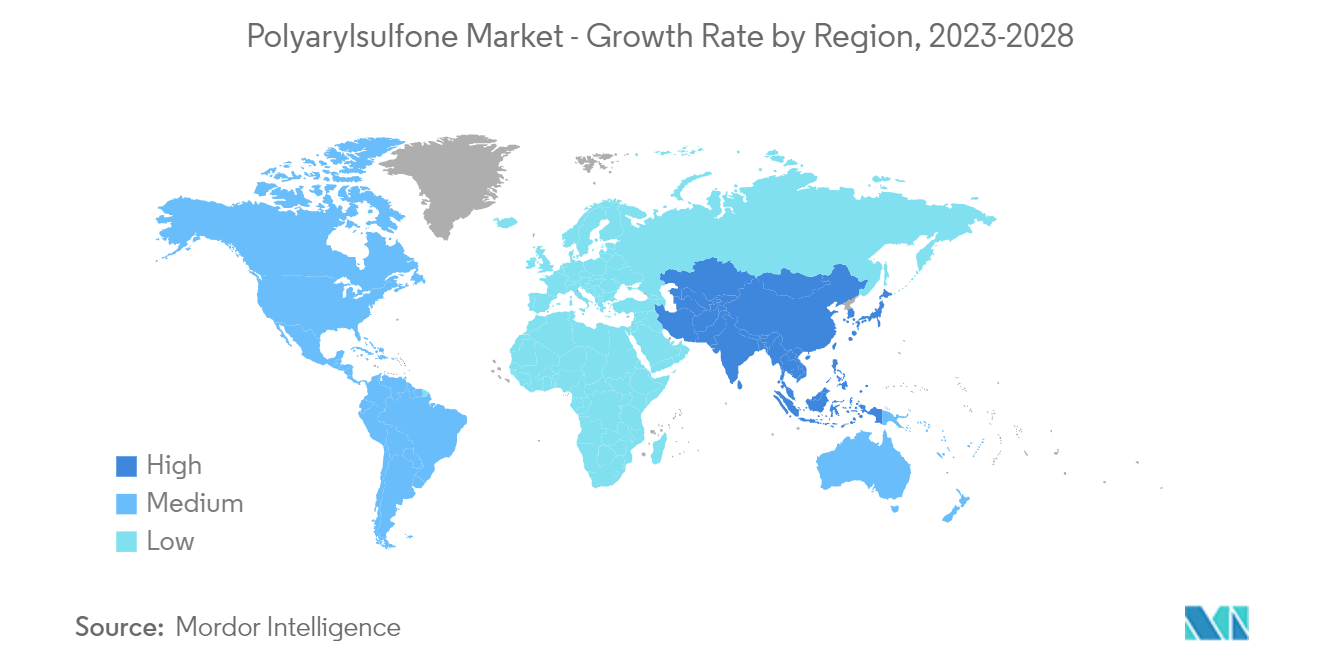
Polyarylsulfone Industry Overview
The global polyarylsulfone market is partially consolidated, with only a few major players dominating the market. Some major companies are BASF SE, Solvay, SABIC, Mitsubishi Chemical Advanced Materials, and Sumitomo Chemical Company.
Polyarylsulfone Market Leaders
-
BASF SE
-
Solvay
-
SABIC
-
Mitsubishi Chemical Advanced Materials
-
Sumitomo Chemical Company
*Disclaimer: Major Players sorted in no particular order
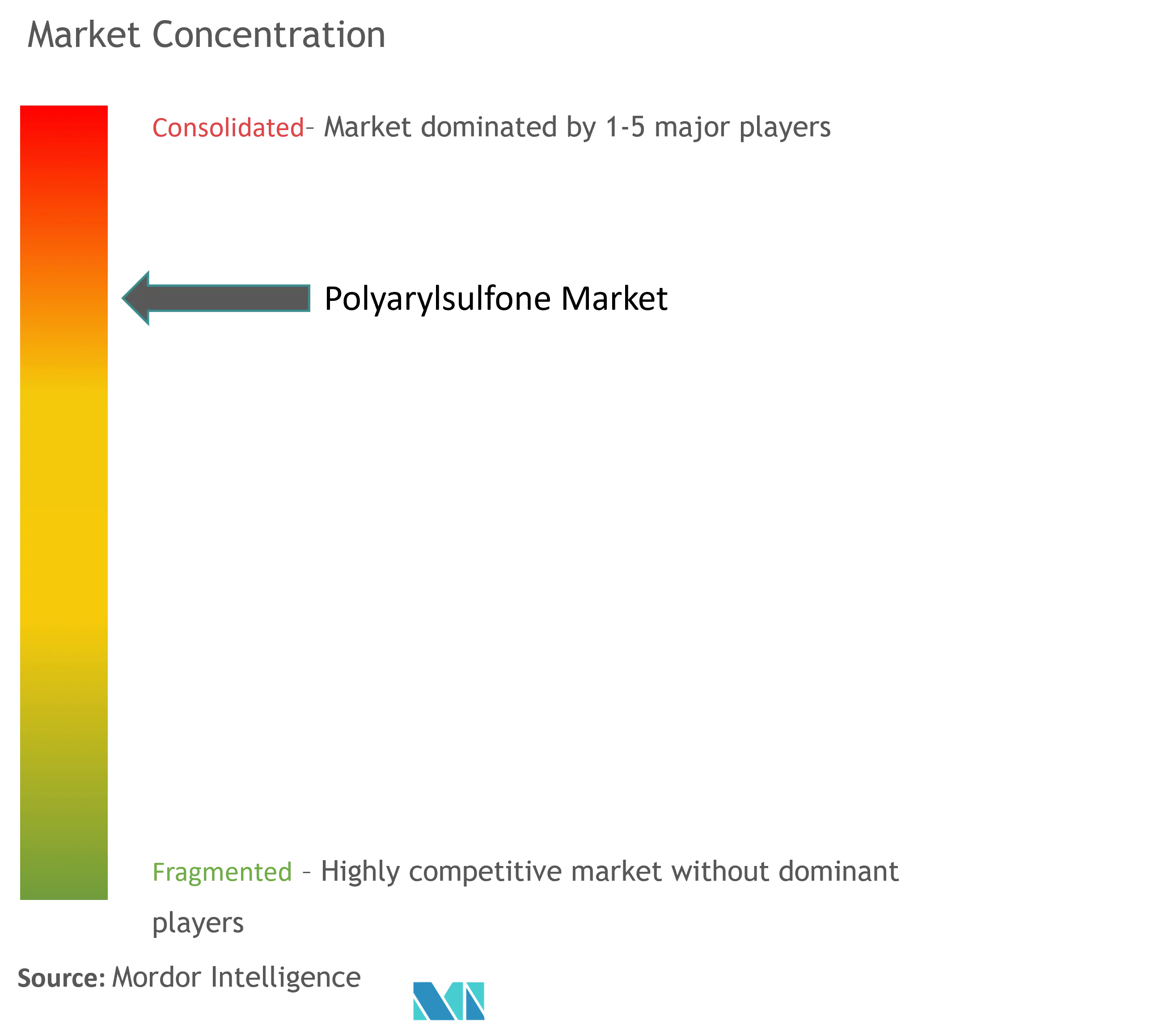
Polyarylsulfone Market News
- The recent developments about the major players in the market are being covered in the complete study.
Polyarylsulfone Market Report - Table of Contents
1. INTRODUCTION
- 1.1 Study Assumptions
- 1.2 Scope of the Study
2. RESEARCH METHODOLOGY
3. EXECUTIVE SUMMARY
4. MARKET DYNAMICS
-
4.1 Drivers
- 4.1.1 Growing Demand of Polyarylsulfone from Automotive Industry
- 4.1.2 Other Drivers
-
4.2 Restraints
- 4.2.1 Stringent Regulations on the Hazardous Nature of Raw Materials
- 4.2.2 Impact of COVID - 19
- 4.2.3 Other Restrains
- 4.3 Industry Value Chain Analysis
-
4.4 Porter's Five Forces Analysis
- 4.4.1 Bargaining Power of Suppliers
- 4.4.2 Bargaining Power of Buyers
- 4.4.3 Threat of New Entrants
- 4.4.4 Threat of Substitute Products
- 4.4.5 Degree of Competition
5. MARKET SEGMENTATION (Market Size in Value)
-
5.1 Type
- 5.1.1 Polysulfone(PSU)
- 5.1.2 Polyethersulfone(PESU)
- 5.1.3 Polyphenylsulfone(PPSU)
- 5.1.4 Polyethylenimine(PEI)
-
5.2 End-User Industry
- 5.2.1 Automotive
- 5.2.2 Aerospace
- 5.2.3 Electronics
- 5.2.4 Medical
- 5.2.5 Mechanical
- 5.2.6 Others
-
5.3 Geography
- 5.3.1 Asia-Pacific
- 5.3.1.1 China
- 5.3.1.2 India
- 5.3.1.3 Japan
- 5.3.1.4 South Korea
- 5.3.1.5 Rest of Asia-Pacific
- 5.3.2 North America
- 5.3.2.1 United States
- 5.3.2.2 Canada
- 5.3.2.3 Mexico
- 5.3.3 Europe
- 5.3.3.1 Germany
- 5.3.3.2 United Kingdom
- 5.3.3.3 France
- 5.3.3.4 Italy
- 5.3.3.5 Rest of Europe
- 5.3.4 South America
- 5.3.4.1 Brazil
- 5.3.4.2 Argentina
- 5.3.4.3 Rest of South America
- 5.3.5 Middle-East and Africa
- 5.3.5.1 Saudi Arabia
- 5.3.5.2 South Africa
- 5.3.5.3 Rest of Middle-East and Africa
6. COMPETITIVE LANDSCAPE
- 6.1 Mergers and Acquisitions, Joint Ventures, Collaborations, and Agreements
- 6.2 Market Share/Ranking Analysis**
- 6.3 Strategies Adopted by Leading Players
-
6.4 Company Profiles
- 6.4.1 BASF SE
- 6.4.2 Bayer AG
- 6.4.3 Ensinger
- 6.4.4 Mitsubishi Chemical Advanced Materials
- 6.4.5 Polymer Dynamix
- 6.4.6 Polymer Industries
- 6.4.7 RTP Company,
- 6.4.8 SABIC
- 6.4.9 Solvay
- 6.4.10 Sumitomo Chemical Company
- 6.4.11 Techmer PM
- 6.4.12 Westlake Plastics Company, Inc.
- *List Not Exhaustive
7. MARKET OPPORTUNITIES AND FUTURE TRENDS
- 7.1 Growing Demand of Polyarylsulfone as Membrane in Water Treatment Facilities
- 7.2 Other Opportunities
Polyarylsulfone Industry Segmentation
Polyarylsulfones are a family of high-performance thermoplastics which contain an aryl-SO2-aryl subunit and are known for their toughness and stability at high temperatures. The amorphous high-temperature polymers of the polyarylsulfone family are characterized by extraordinary, inherent flame retardancy and high transparency. The polyarylsulfone market is segmented by type, end-user industry, and geography. The market is segmented by type into polysulfone, polyethersulfone, polyphenylsulfone, and polyethyleneimine. The end-user industry segments the market into automotive, aerospace, electronics, medical, mechanical, and other industries. The report also covers the market size and forecasts for polyarylsulfone in 17 countries across major regions. Each segment's market sizing and forecasts are based on revenue (USD million).
| Type | Polysulfone(PSU) | |
| Polyethersulfone(PESU) | ||
| Polyphenylsulfone(PPSU) | ||
| Polyethylenimine(PEI) | ||
| End-User Industry | Automotive | |
| Aerospace | ||
| Electronics | ||
| Medical | ||
| Mechanical | ||
| Others | ||
| Geography | Asia-Pacific | China |
| India | ||
| Japan | ||
| South Korea | ||
| Rest of Asia-Pacific | ||
| Geography | North America | United States |
| Canada | ||
| Mexico | ||
| Geography | Europe | Germany |
| United Kingdom | ||
| France | ||
| Italy | ||
| Rest of Europe | ||
| Geography | South America | Brazil |
| Argentina | ||
| Rest of South America | ||
| Geography | Middle-East and Africa | Saudi Arabia |
| South Africa | ||
| Rest of Middle-East and Africa |
Polyarylsulfone Market Research FAQs
What is the current Polyarylsulfone Market size?
The Polyarylsulfone Market is projected to register a CAGR of less than 6% during the forecast period (2024-2029)
Who are the key players in Polyarylsulfone Market?
BASF SE , Solvay, SABIC, Mitsubishi Chemical Advanced Materials and Sumitomo Chemical Company are the major companies operating in the Polyarylsulfone Market.
Which is the fastest growing region in Polyarylsulfone Market?
Asia Pacific is estimated to grow at the highest CAGR over the forecast period (2024-2029).
Which region has the biggest share in Polyarylsulfone Market?
In 2024, the Asia Pacific accounts for the largest market share in Polyarylsulfone Market.
What years does this Polyarylsulfone Market cover?
The report covers the Polyarylsulfone Market historical market size for years: 2019, 2020, 2021, 2022 and 2023. The report also forecasts the Polyarylsulfone Market size for years: 2024, 2025, 2026, 2027, 2028 and 2029.
Polyarylsulfone Industry Report
Statistics for the 2024 Polyarylsulfone market share, size and revenue growth rate, created by Mordor Intelligence™ Industry Reports. Polyarylsulfone analysis includes a market forecast outlook to 2029 and historical overview. Get a sample of this industry analysis as a free report PDF download.



